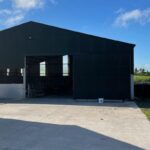In this week’s sheep farmer segment, That’s Farming, speaks to Raymond Douglas from the Annamacneil flock in Monaghan. He discusses taking over his first farm as a teen, constructing a TAMS-approved sheep shed, achieving up to €2,000 for progeny, the sector’s challenges and plans.
Over thirty years ago, Raymond Douglas, a then 16-year-old, took over his grandfather William Douglas’s existing suckler cow enterprise but found it “difficult” to juggle this with his further education.
He then farmed up to 60 pure Mule and Suffolk-cross sheep with a Charollais ram for ten years, which he later phased out over four years to farm up to 35 pedigree Charollais sheep.
In 2012, Raymond established his flock by acquiring his first ewes at the Dungannon Charollais sheep female sale, with further purchases at the Irish Charollais Sheep Society female sale in Tullow Mart, the Worcester premier sale, the UK, and on-farm sales.
The Ballybay, County Monaghan native’s father, Ronnie, is “invaluable” to the farm’s running and his grandfather, Ronnie Hollinger, a past Irish Charollais Sheep Society member, influential in the breed choice.
“I was using Charolais rams and subsequently found myself starting to breed Charollais rams,” Raymond Douglas told That’s Farming.
“I always had an interest in farming, and I suppose that was my introduction to Charollais sheep.”
Annamacneil flock
The flock keeps its replacements and buys breeding ewes or ewe lambs annually.
Raymond selects a Charollais ram that is “correct,” “well-muscled”, with a “solid backend” and “skin”, and when it comes to ewe selection, he likes to see that “sparkle.”
The enterprise conducts ET work on two of its “best” ewes annually and is in the fourth year of undertaking the procedure, which AB Europe complete.
Raymond uses some of the “top” rams available, including Foxhill Va Va Voom – and has an average flush yield of 8-10 embryos per ewe.
His stock rams include Springhill Wildcard from Graham Foster, a private purchase, and a homebred ram, Annamacneil Wonderboy.
Raymond aims to achieve a compact lambing period, with 80% lambing in the first week of January.
“For example, a ram would have seven ewes today, and three days later, another seven. We stagger sponging to suit aiming lambing in the first week of January.”
Lambing
Raymond lambs his pedigree Charollais ewes in the first week of January in accordance with society rules and takes annual leave during this period.
He houses lambs indoors by night and outdoors by day until weather permits to enable him to move them outdoors permanently.
Five years ago, the Monaghan farmer invested in a lambing shed, one half of which is a slatted area and the other contains straw-bedded lambing pens.
He received a TAMS grant for an IAE Sheep System with galvanised gates, four pens, a sheep run, a drafting gate and a large footbath.
“I suppose being in full-time employment, I needed to leave things as simple and easy as possible. I spent Saturdays working at the sheep, so the handling system I put in was invaluable.”
“It means I can work away on my own, and even for gathering up sheep, I do not have a dog, but I find a quad is as good as a dog.”
“I gather up the sheep myself, and I can work away with the handling system I have on my own.”
The farm’s next investment for the upcoming lambing season will be a camera.
Progeny
He operates a strict culling policy, by retaining circa ten replacements, selling up to ten ewe lambs in November sales at Ballybofey & Stranorlar Co-operative Livestock Mart and cull ewes and lambs not eligible for breeding to Kepak Athleague in April or May.
He sells his rams at Cootehill Livestock Mart, Blessington Mart, Ballybofey & Stranorlar Co-operative Livestock Mart, Tullow Mart from the end of July to the end of September.
Over the past few years, Raymond secured just shy of €900 for rams and touched up to €2,000 for ewe lambs.
“I suppose in the early days; I depended on society sales. However, over the last few years with a few repeat customers, I notice the home trade building as people get to recognise the flock and through word of mouth.”
“It is keeping a balance between input costs and what you get for your lamb.”
“So, that is why I strive to produce the best ram I can for selling. In that way, hopefully, you get some top prices at those sales. My motto would be quality over quantity in terms of rams and ewes I keep.”
“I suppose for me, it is to keep quality high and quantity low for your stock to breed off and buy the best ewes you could afford. Do not rush and build your flock up over a number of years with quality.”
“I did well to break even for the first few years I was full-time at pedigree sheep. However, it is only in the last number of years that sheep has become a viable enterprise.”
“Unfortunately, I think it would be difficult to see the days of keeping a small flock of commercial sheep viable. I can see flocks having to get bigger and well-managed to be viable.”
“I think an off-farm job is necessary, and at the scale, I am at, you could not survive on sheep farming,” the father of Hannah (8) and Noah (2) concluded.
To share your story like this sheep farmer, email Catherina Cunnane, editor of That’s Farming, – [email protected]
See more sheep farming profiles













